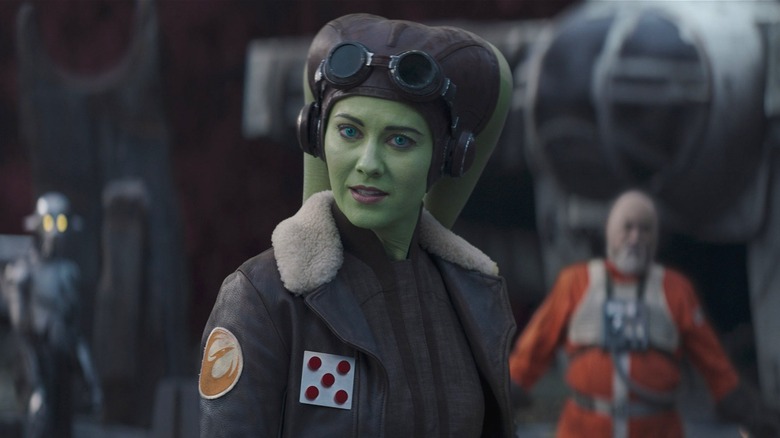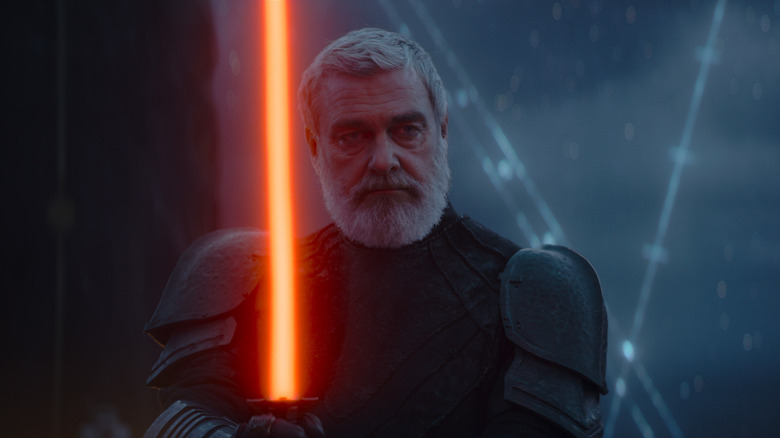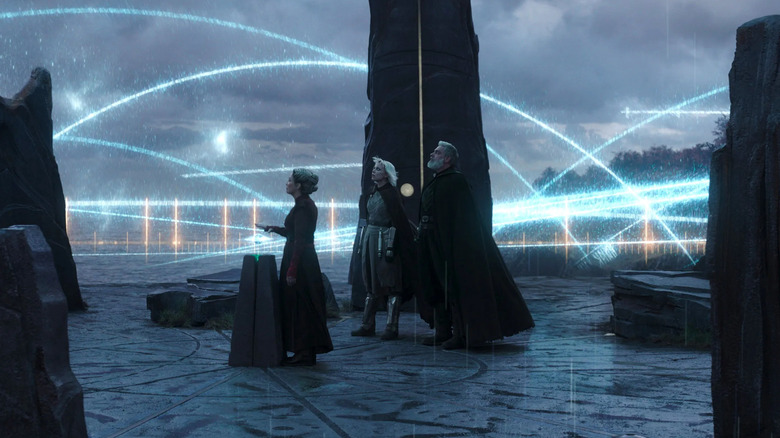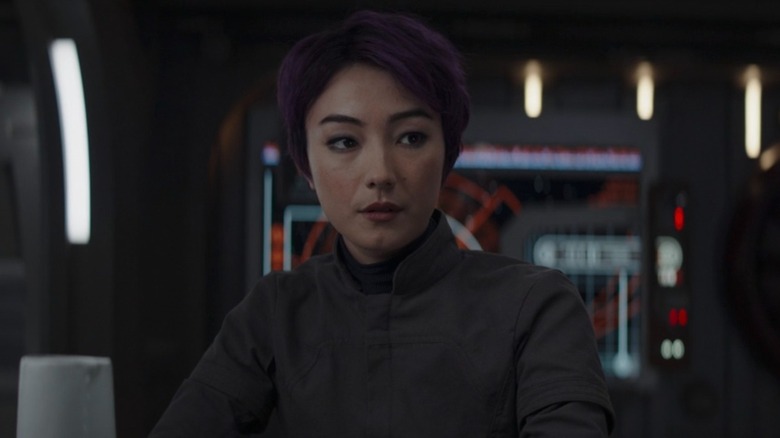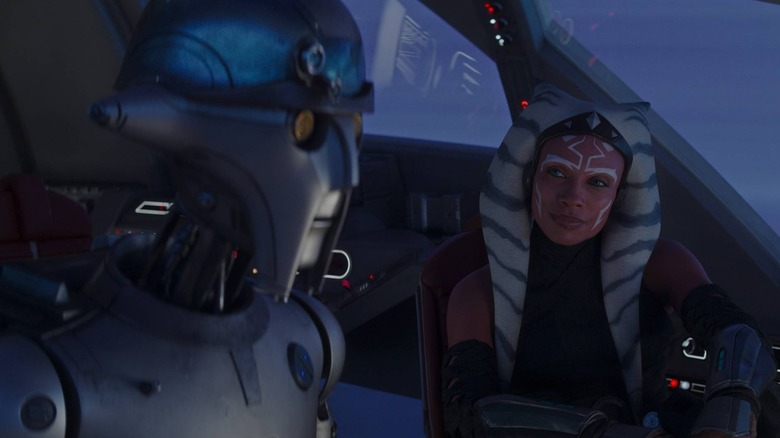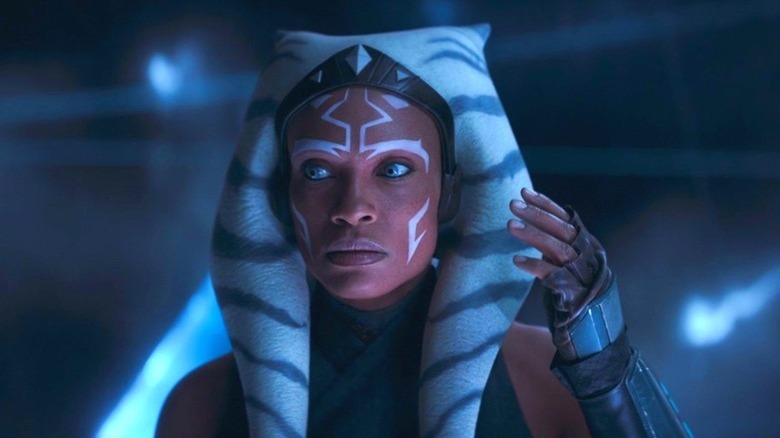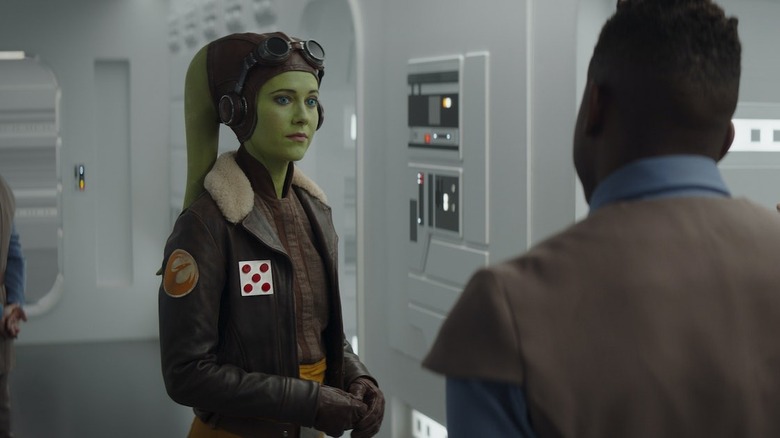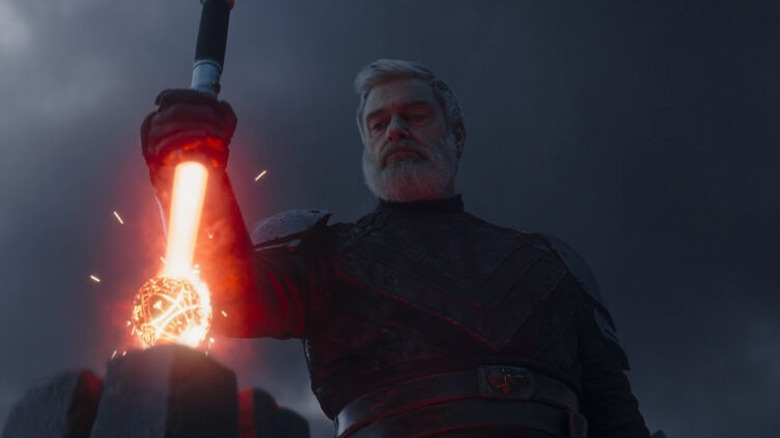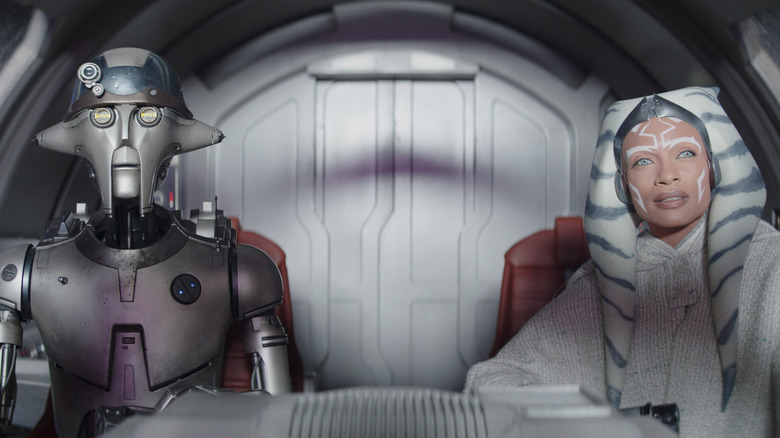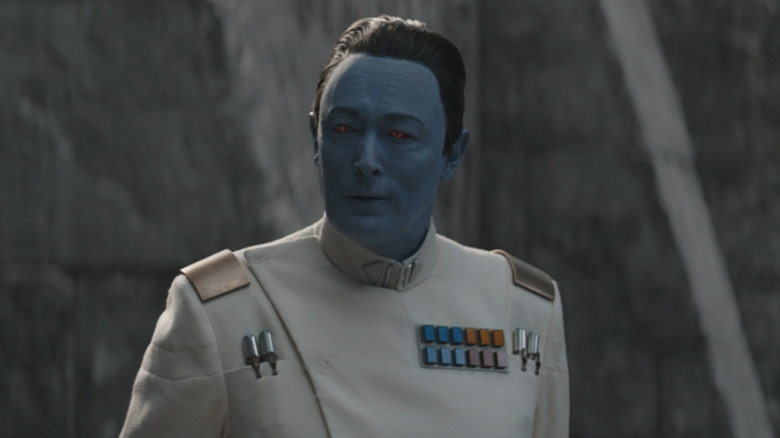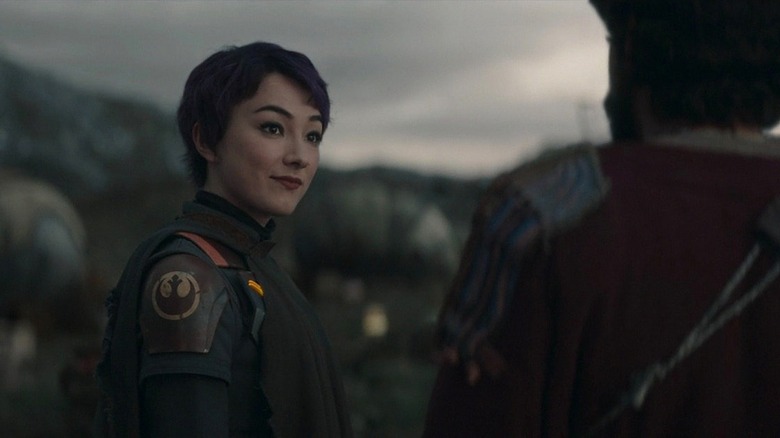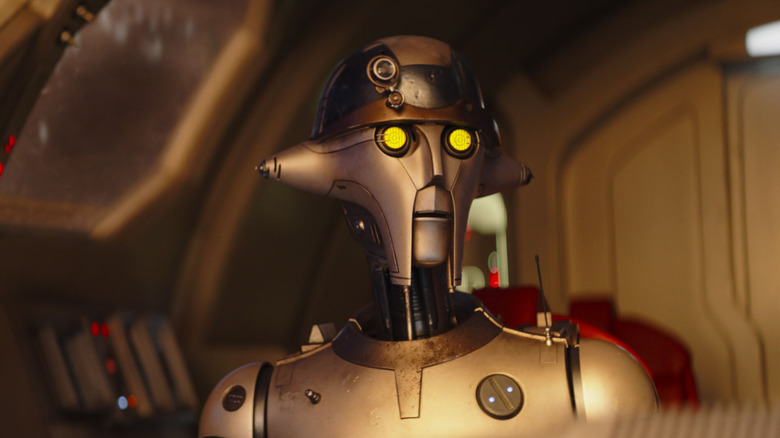Lines In Ahsoka That Are More Important Than You Think
There was a time when "Star Wars" told a linear story centered around one (particularly high in midichlorian-count) bloodline. Today, "Star Wars" is an ever-expanding universe of interconnected stories that jump around time and space and spin ever farther away from the Skywalkers' orbit (though even in projects that aren't explicitly about them, it seems there's always room for Anakin, Luke, or Leia). The new center of the "Star Wars" galaxy, however, could be Ahsoka Tano, played in live-action by Rosario Dawson since her debut appearance in Season 2 of "The Mandalorian." Ahsoka was one of the primary characters in what is, at least in terms of runtime, the franchise's most lore-dense project to date, "The Clone Wars." She's a creation of current Executive Creative Director of Lucasfilm Dave Filoni, who also heads up the series named after her. And she's a character who's come into contact with characters from several other "Star Wars" films and shows.
"Ahsoka" Season 1, all eight parts of which are now airing in their entirety on Disney+, begins the process of knitting together the disparate "Star Wars" projects from the last 20 or so years. Its actual storyline is quite linear and condensed, but Grand Admiral Thrawn's (Lars Mikkelsen) return combined with the introduction of an entirely new galaxy means big things for the overall continuity and scope of the "Star Wars" saga. As such, "Ahsoka" is loaded with words, phrases, and lines that point forward and backward, from obscure "Star Wars" references to mythology and literature from our own galaxy. These are the hidden meanings you may have missed in Season 1 of "Ahsoka."
We are no Jedi
Episode 1, titled "Master and Apprentice," begins as an unidentified starship requests access to a New Republic cruiser. The ship's inhabitants claim to be Jedi, and they give Captain Hayle (Mark Rolston) old Jedi clearance codes. This being approximately three decades after Order 66, Jedi are few and far between. Hayle is suspicious. "You are no Jedi," he says accusingly. Baylan Skoll (Ray Stevenson) and his apprentice, Shin Hati (Ivanna Sakhno), only keep up the ruse for so long before revealing their orange lightsabers and laying waste to the cruiser's crew.
"You're right about one thing, Captain," Baylan says. "We are no Jedi." Combined with context clues like the codes and the lightsaber, this short quote allows us to guess that Baylan was once a legitimate Jedi but no longer considers himself to be a member of the Order. When he does what he came to do — free Morgan Elsbeth (Diana Lee Inosanto) from her prison cell — we learn that he's currently working as a mercenary, and a well-paid one at that.
But this line is also an allusion to an important moment from Ahsoka Tano's past. In a pivotal scene from Season 2 of "Star Wars Rebels," Ahsoka (voiced by Ashley Eckstein) comes face-to-face with her former master, Anakin Skywalker-slash-Darth Vader (voiced by Matt Lanter and James Earl Jones). She tells Vader that she's going to avenge Anakin's death. He reminds her that revenge isn't the Jedi way. "I am no Jedi," she spits back at him before activating her twin white sabers. Both Ahsoka Tano and Baylan Skoll represent the moral gray area of the Force in a post-Order 66 "Star Wars" world.
Toil and trouble
"Toil and Trouble" — not a line, per se, but the title of Episode 2 — is a phrase that viewers may have seen or heard before, perhaps on Halloween paraphernalia or in song in "Harry Potter." It comes from William Shakespeare's "Macbeth." The full line of dialogue from the song of the witches goes, "Double, double toil and trouble; fire burn and cauldron bubble," and is repeated again. In the scene in question, three witches or "weird sisters" are brewing a potion. Though scholars have debated Shakespeare's exact meaning, the witches can be interpreted as being supernaturally powerful and shrewd judges of men's weakness. In Macbeth's case, ambition is his vulnerability. The witches are either predicting (or directly causing with a curse) a doubly tragic fate for the king and his kingdom.
"Ahsoka" is full of references to witches and witchcraft. In Episode 1, we learn that Morgan Elsbeth is a descendant of the Nightsisters of Dathomir, a coven of Force-sensitive witches (they call it magick) who appears in live-action for the first time in the series. In Episode 2, we see Elsbeth using this magick to map the mythical Path to Peridea, and in Episodes 6 and 7, we see three Nightsisters (Jeryl Prescott Gallien, Claudia Black and Jane Edwina) who speak in unison, have mystical foresight, and bear a striking resemblance to the three witches in "Macbeth."
But "Toil and Trouble" isn't just a nod to the weird sisters. In Shakespeare's play, the line foreshadows the ambitious Macbeth's downfall, but only after he conspires, ascends to rule, and causes war ... which could ultimately describe Thrawn's arc in the future.
You realize, historically, there have been very few Mandalorians who ever became a Jedi
Audiences met Sabine Wren in "Star Wars Rebels" (where she was voiced by Tiya Sircar). During that show's four seasons, we learned quite a lot about the Mandalorian with a talent for street art. She was once an Imperial cadet who cut ties with her family to team up with the crew of the Ghost, and she went on to become a hero to her people (she even possessed the Darksaber for a while) and to the New Republic. However, "Ahsoka" makes it clear that we don't know everything about her. At some point between the two series, Ahsoka Tano took Sabine (Natasha Liu Bordizzo) on as an apprentice, and the two had a falling out. During the events of "Ahsoka," they're trying to mend their relationship, and Sabine is training to be a Jedi again.
In Episode 3, as if to lower our expectations, Huyang (David Tennant) tells Ahsoka that, "Historically, there have been very few Mandalorians who ever became a Jedi." This throwaway insult to Sabine is actually an extremely consequential, potentially canon-changing line for "Star Wars." Sabine can't yet be called a proper Jedi, which leaves only one known official Mandalorian Force user. Tarre Vizsla is the first and thus far only known Mandalorian Jedi. He's also the creator of the now-destroyed Darksaber, as well as the ancestor of Pre Vizsla and Paz Vizsla. His only appearance comes in a single episode of "Star Wars Rebels," in flashback. Now, in "The Mandalorian," Grogu's path seems to be trying to combine the Mandalorian and Jedi lifestyles as well. Huyang's line suggests that Mandalorians are seen as unlikely candidates for apprenticeship, but it also indicates that they did exist beyond Tarre Vizsla.
I suppose you do come from a long line of nontraditional Jedi
Speaking of Sabine's fraught apprenticeship, Huyang makes another excuse for her in Episode 3, only moments later. "Well, I suppose you do come from a long line of nontraditional Jedi," he laments to Ahsoka Tano. "In that way, she fits right in." The ancient droid whose sole purpose has been to educate young Jedi would know. His artificial memory can recall every Jedi who ever came through the temple, and he's right that Ahsoka and Sabine are the continuation of what's probably the most interesting but problematic lineage in the Order's history.
There's strong-willed Sabine, who can't currently do anything with the Force but connect to her master's thoughts, and who may have sentenced the galaxy to war by disobeying orders. Then there's Ahsoka, who left the Jedi when she was falsely accused of committing a terrorist attack against the temple. Though she was eventually proven to be innocent, she was already so disillusioned with the Jedi that she chose not to return. Of course, Ahsoka's master was none other than Anakin Skywalker, whose fear precipitated his fall from Chosen One to Sith Lord. Anakin's Master was Obi-Wan Kenobi, who, along with Yoda, only partially trained Luke Skywalker. Obi-Wan's mentor was Qui-Gon Jinn, who went against the Jedi Council's wisdom in training Anakin. Qui-Gonn's Master was Count Dooku (another Jedi turned Sith), and Dooku's was Yoda, a member of a species so rare, it doesn't have a name. In short, this is a powerful but chaotic and trouble-causing lineage if ever there was one.
Better that than allowing Thrawn's return as heir to the Empire
Episode 4 presents Ahsoka Tano and Sabine Wren with a difficult choice. They know they're losing the battle to get to Peridea first, so Ahsoka floats the idea of not going at all and making sure nobody else can get there either. "He'll be stranded out there," Sabine argues, meaning Ezra Bridger (Eman Esfandi). "Maybe this time for good." "Better that than allowing Thrawn's return as heir to the Empire," Ahsoka replies.
In the world of the show, Ahsoka is calculating that saving Ezra may well come at the cost of a restored Empire, under the brilliant tactician Thrawn's command. Because Grand Admiral Thrawn is very likely being primed to serve as the new overarching villain a la Emperor Palpatine (Ian McDiarmid) or Darth Vader, it's also very likely that he is, indeed, going to make it back to the galaxy in which all of "Star Wars" until now has taken place. That means "Ahsoka" is almost certainly going to be a story about our heroes losing the day, and maybe even losing the war, which will usher in the First Order.
In the wider world of the franchise, however, this line harkens back to the title of the book that gave us Thrawn in the first place. Timothy Zahn's "Heir to the Empire" (which is no longer canon) introduced "Star Wars" fans to the character back in 1991, when the Chiss military strategist staged an Imperial comeback against Luke Skywalker, Hans Solo, and a pregnant Leia Organa. Coincidentally, "Heir to the Empire" is set around the same time as "Ahsoka."
On your signal, Phoenix Leader
General Hera Syndulla (Mary Elizabeth Winstead) is another character who has made the hyperspace jump from animation to live action. In "Ahsoka," she's largely been relegated to B-plots that see her grow frustrated with the inaction of the New Republic's government. Those who met Hera during her Rebel days will remember that the Twi'lek was the pilot of the Ghost as well as a de facto leader and mother figure to its crew. She also had a child with her romantic partner, the late Jedi Kanan Jarrus (voiced by Freddie Prinze Jr.). That child, Jacen (Evan Whitten), appears in "Ahsoka," eager to follow in his father's footsteps.
As she did during the rebellion, Hera commands a squadron that shows up to aid Ahsoka and Sabine in their efforts to beat the Imperial remnant at their game. During their mission, another pilot refers to her as "Phoenix Leader." This was Hera's call sign from her days as a resistance fighter, when anti-Imperialist forces still operated in splintered cells throughout the galaxy. Hera rose to the top of Phoenix cell, which eventually took on Grand Admiral Thrawn during a battle over their secret base on Atollon.
Similarly, the word "Fulcrum" is also used as a codename in "Ahsoka." The title character took Fulcrum for a pseudonym for a while, as have several other Rebels in the years between the end of the Clone Wars and the fall of the Empire. In "Star Wars Rebels," Agent Kallus (David Oyelowo) went by Fulcrum (and was eventually found out by Thrawn), as did Cassian Andor (Diego Luna) in "Andor."
Do it
Episode 4's title, "Fallen Jedi," could apply to several characters. Baylan Skoll practically self-identifies as a fallen Jedi. Ahsoka Tano has renounced the Order, too. More literally, she falls to what we and the other characters are meant to believe is her death. With her master out of the picture, Sabine Wren is left to fend for herself against Baylan. She doesn't have a physical fight ahead of her but a battle of wills, one in which she does not prevail. Ahsoka told her to destroy the orb that contains the star map to Peridea so that nobody could reach the galaxy where Thrawn and Ezra are presumed to be. Baylan fairly easily persuades her to do otherwise.
He promises that if she makes the journey possible and comes with him willingly, he will not harm her. "It's the only way," he says. "Do it." What he wants is for her to hand over the map. "For Ezra," he adds. That's all the nudging she needs. Sabine gives in, Morgan is able to complete the calculations, and Baylan destroys the orb so that they can't be followed. This simple two-word sentence, "Do it," was famously uttered by another dark lord during a moment of indecision. Palpatine instructed Anakin Skywalker (Hayden Christensen) to "do it" when he had Count Dooku's (Christopher Lee) head between two lightsaber blades. The Chancellor's tone was decidedly more villainous. Anakin believed he was acting in service of the greater good in killing a Sith lord. Sabine, on the other hand, is taking a risk to save one life.
History of the Galaxy, Parts One, Two, and Three
As they're traveling in the mouth of a Purrgil to Peridea, Ahsoka tells Huyang that she remembers the tales he used to tell Younglings back at the temple. "Ah yes, History of the Galaxy, Parts One, Two, and Three," Huyang reminisces. "One being the best, of course," Ahsoka adds. The droid reminds her that these legends are still stored in his internal memory, and to help her relax, he offers to read to her from his hard drive. At first, she declines. She's worried about Sabine and what they'll find if and when they get to Peridea. But before the cold open is over, she relents, and Huyang begins his story with the phrase, "A long time ago, in a galaxy far, far away ...."
That last line should be familiar to even the most casual "Star Wars" fans. It's the start of the first opening crawl in 1977's "Star Wars: Episode IV — A New Hope." Just as George Lucas was telling audiences a story that took place a long time ago, in a galaxy far, far away (the primary "Star Wars" galaxy in the decades just before and after the Battle of Yavin), Huyang was educating his students about a distant place and time (perhaps this new galaxy, tens of thousands of years in their past). There's also an implication that Huyang is functionally the franchise's narrator. The bit about the History of the Galaxy being told in three parts, with Part One being the best, is an even cheekier joke and an admission that the original trilogy remains the most popular.
I want to know her background, history, homeworld, her Master, everything
Grand Admiral Thrawn doesn't cover his body in iconic black armor or fight with a lightsaber. He's terrifying because he's so good at what he does, and that's outthink his adversaries. In the books and comics in which he appears, and in "Star Wars Rebels," Thrawn frequently relies on a tactic that he's honed since his earliest military days in the Chiss Ascendancy. He uses his vast knowledge of various planets' and species' cultures to get into the heads of those who endeavor to defeat him, whether that's an individual or an entire society. Thrawn was able to manipulate Hera Syndulla (voiced by Vanessa Marshall) just this way by learning about and stealing a family totem called a Kalikori that was important to her.
In Episode 6, titled "Far, Far Away," Thrawn and the Nightsisters realize Ahsoka is alive and headed their way. After shaming Morgan Elsbeth for underestimating her, he says, "I want to know her background, history, homeworld, her Master, everything." This is not only in keeping with the grand admiral's character, but it's also in keeping with where the players have been on the board up until now. Ahsoka exits "Star Wars Rebels" at the end of Season 2, just when Thrawn is being introduced as Season 3's new villain. They've never met, but they do share a mutual friend: Anakin Skywalker. Thrawn fought with Anakin briefly during the Clone Wars, so when he discovers that Anakin was Ahsoka's master, it's vitally important information that he can use against her.
That's what people say
Some fans may have scratched their heads a bit at the nature of Sabine Wren and Ezra Bridger's reunion in Episode 6. It's been more than 10 years since Ezra disappeared, during which the entire original trilogy as well as the events of "The Mandalorian" and "The Book of Boba Fett" have taken place. Surely the marooned rebel would want to know how things turned out. That situation is remedied in Episode 7, "Dreams and Madness." While traveling with the nomadic Noti, Ezra tells Sabine that he's still trying to process the update she's given him. As if to make absolutely sure, he asks, "The Empire was defeated?" to which she answers, "Battle of Endor." "The Emperor died?" he continues. "That's what people say," Sabine quips back. This nonchalant reply is a sly retcon to one of the least popular plot points in "Star Wars" history: Palpatine's resurrection.
Her line also undoubtedly reminded viewers of what might be the single worst line of dialogue in the entire franchise. In "Star Wars: Episode IX — The Rise of Skywalker," Poe Dameron (Oscar Isaac) offers, "Somehow Palpatine returned." And sure enough, a reanimated Darth Sidious faces off against his granddaughter (Daisy Ridley) and an uncorrupted Ben Solo (Adam Driver). Sabine's comment gives in-world plausibility to the idea that Palpie was never really gone.
Clever boy, Caleb was
In the finale, titled "The Jedi, the Witch, and the Warlord," Ezra Bridger constructs a new lightsaber from parts found in Ahsoka's shuttle. Huyang's annoyed that Ezra's messing up his organizational system and that the Jedi in need of a weapon won't let him help. He reminds Ezra that he's assisted almost every Jedi who has ever gone through the temple with this task, including his master. Sabine utters his name ... the deceased Kanan Jarrus. But Huyang refers to him by another name altogether. "Clever boy, Caleb was," the droid says. "Very curious."
Much of "Ahsoka" is pitched to and can best be appreciated by those who watched "Star Wars Rebels" — if not in its entirety, then at least enough to recognize the animated series' main characters. Huyang's use of the name Caleb will go over the heads of even a portion of that audience. Kanan Jarrus — Hera Syndulla's romantic partner and Ezra's Master — was born Caleb Dume. He was still a Padawan when he survived Order 66, and eventually, he took the name Kanan Jarrus in order to conceal his identity and status as a former Jedi trainee. That Huyang knows Kanan as Caleb is veritable proof that the two really were acquainted back in Kanan's days as a youngling, and it's also an Easter egg for the character's biggest fans, since regrettably, we won't get to see him in live-action.
